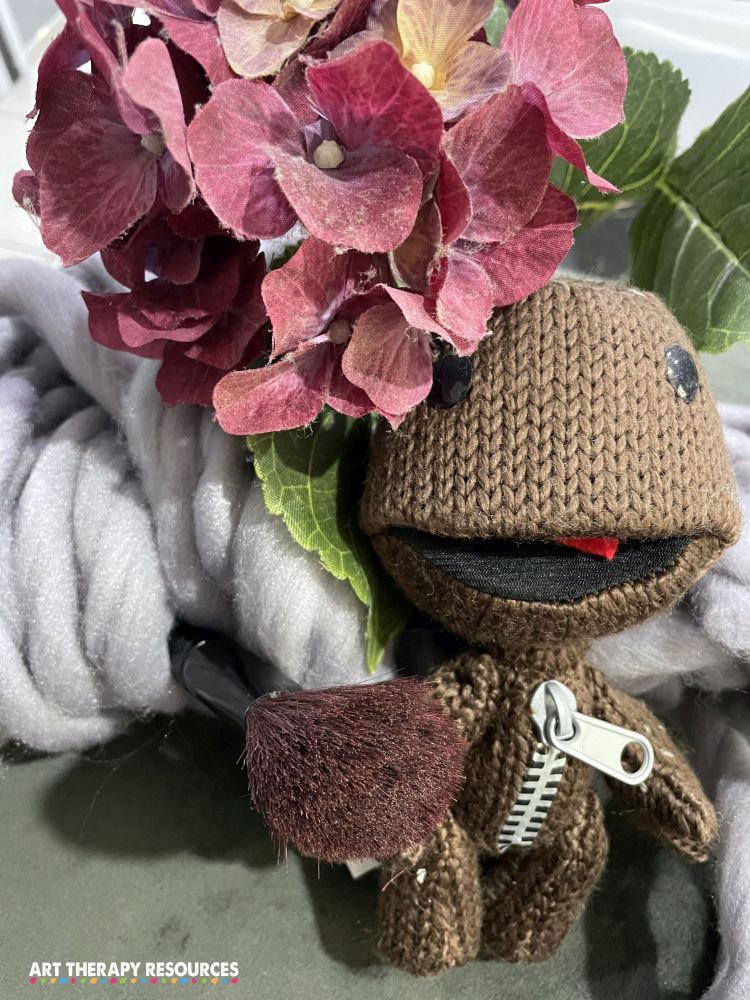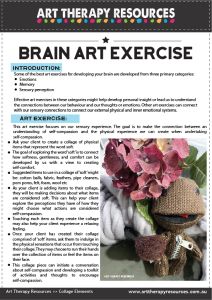THIS POST INCLUDES:
1. Your brain as a ‘muscle’
2. How art improves brain function
3. Art therapy and brain function
4. Art exercises for your brain
5. Free Art Therapy Exercise
YOUR BRAIN AS A MUSCLE
When we refer to the brain as a muscle, this isn’t an anatomical reference although it does contain some muscle. The brain is referred to as a muscle in a metaphorical sense as the daily use of your brain develops the overall strength of your physical system. This is important as the brain provides a supportive function for the rest of your body.
Neuroplasticity is often referred to as the muscle-building component of our brain as it represents the physiological changes that the brain undergoes in response to learning and processing stimuli.
HOW ART IMPROVES BRAIN FUNCTION
Art plays an important part in developing and maintaining important brain functions. Art activates neural networks and functions in the brain including the below:
- Learning
- Memory
- Emotions
- Pleasure
- Sensory-motor integration
Most of us can recall an experience of looking at art that made us feel inspired, motivated, or engaged in some form of positive emotions.
Furthermore, you may recall an experience where art has triggered a memory. Art activates a sensory part of our brain that actively engages our brain in interpreting and analyzing what we see.
These reactions to art show us that art can play an important part in affecting our brain function.
Looking at art also increases wellbeing as it activates our pleasure centres in the same way that engaging with a loved one does. Furthermore, our senses absorb our environment and reflect how we interpret those inputs through our behaviour. When we experience a positive sensation from viewing beautiful art, we in turn reflect our positivity. These positive feelings can include awe, wonder, inspiration, and appreciation.
Direct benefits of art improving brain function include:
- Reduces stress through lowering cortisol levels
- Improves cognitive function
- Develops neural connections
- Facilitates communication
- Facilitates decision making
- Provides focused attention
- Develops sensory understanding
Art can help improve brain function by helping us reframe experiences and explore personal insights about the world around us.
Art can help us engage in abstract thinking processes that we might not have previously considered on our own. From this perspective, the role of art as stimulation ensures that our brain actively engages in processes similar to a muscle.
ART THERAPY AND BRAIN FUNCTION
While art alone can have enormous benefits to our brains, the field of art therapy can supercharge these benefits to include both cognitive benefits and emotional benefits. Both of these aspects contribute to overall brain function and its development.
Art making plays an important part in recovery for those with traumatic brain injuries. Art removes the need to rely on verbal communication if the client’s injuries have affected Broca’s area which is the area of the brain that is connected with verbal communication skills.
Art therapy relies heavily on developing visual imagery and transferring it to a medium through the creative process. Systems within the brain that organize visual and perceptual functions connect with these processes. Additionally, our brain is also activated when kinesthetic functions are activated through art creation and body movement through physical expression. These movements are not simply a physical function and instead are connected to our emotions.
Art making can create a foundation on which to explore personal experiences, reframe thoughts, and develop personal insights into those experiences. Art enables clients to explore the possibility of change and how it occurs over time through behavioural and cognitive modification. These changes can be difficult to process and art provides the medium in which to explore these difficulties through emotional expression of both the experiences as well as the process of change.
The brain can also be developed through the tactile interaction of art materials. Tactile materials that encompass texture, smell, auditory, and visual attributes help the brain develop a broader view of the environment which influences learning. These attributes can also trigger emotional responses based on a variety of memories. Examples of tactile materials include watercolour, fluid paints, sand, water, rocks, and other byproducts from nature.
An art therapist can help clients to process emotional responses and support memory and learning experiences by the client.
ART EXERCISES FOR YOUR BRAIN
Some of the best art exercises for developing your brain are developed from three primary categories:
- Emotions
- Memory
- Sensory perception
Art exercises can be developed for those clients who are experiencing issues due to brain dysfunction, however, we can also do art exercises that challenge our brain and explore the creative aspects of our brain.
Effective art exercises in this category might help develop personal insight or lead us to understand the connections between our behaviour and our thoughts or emotions. Other art exercises can connect with our sensory connections to connect our external physical and inner emotional systems.
ART THERAPY EXERCISE
This art exercise focuses on our sensory experience.
The goal is to make the connection between an understanding of self-compassion and the physical experience we can create when undertaking self-compassion.
- Ask your client to create a collage of physical items that represent the word soft.
- The goal of exploring the word ‘soft’ is to connect how softness, gentleness, and comfort can be developed by us with a view to creating self-comfort.
- Suggested items to use in a collage of ‘soft’ might be: cotton balls, fabric, feathers, pipe cleaners, pom poms, felt, foam, wool etc
- As your client is adding items to their collage, they will be making decisions about what items are considered soft. This can help your client explore the perceptions they have of how they might choose what actions are considered self-compassion.
- Touching each item as they create the collage may also help your client experience a relaxing feeling.
- Once your client has created their collage comprised of ‘soft’ items, ask them to indulge in the physical sensations that occur from touching their collage. They may choose to run their hands over the collection of items or feel the items on their face.
- This collage piece can initiate a conversation about self-compassion and developing a toolkit of activities and thoughts to encourage self-compassion.
An example is below:

FREE DOWNLOAD: Art Therapy Exercise
SIGN UP below to download the FREE Art Therapy Exercise that focuses on sensory experiences.

BUILD YOUR ART THERAPY REFERENCE MATERIALS:
Pin this image to your Pinterest board.

SHARE KNOWLEDGE & PASS IT ON:
If you’ve enjoyed this post, please share it on Facebook, Twitter, Pinterest. Thank you!
